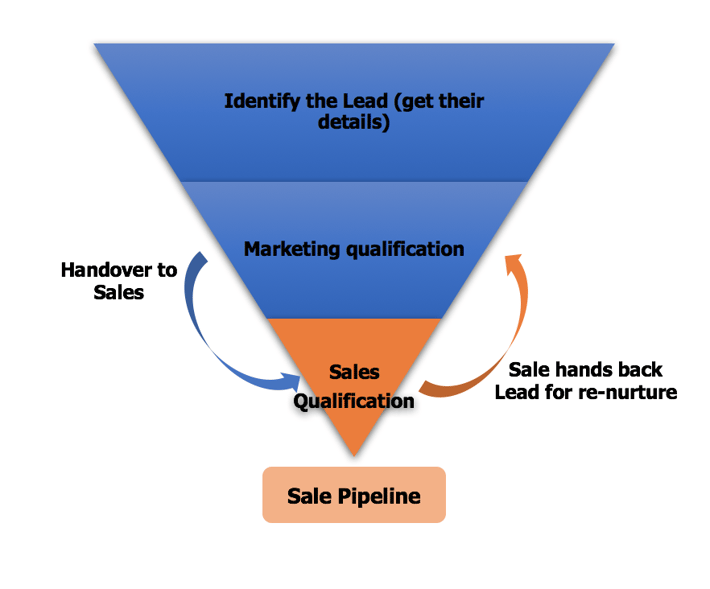Sometimes a lead hits SQL status but isn’t ready for a sale yet. That’s when the Sales team might send a lead back to Marketing that they thought was done and dusted. Here’s what to do next.
Sometimes, you might hit the target - but not perfectly. That’s when sales and marketing needs to work on their relationship and Sales needs to feel comfortable sending back leads that need a little more nurturing to the marketing department.
So, you’ve done all the research, had the meetings, and you’ve got your Sales and Marketing teams aligned.
It’s a process every business should perfect, and once you do, you’ll find that something interesting happens… Sales will hand Marketing back leads. But what are you supposed to do once the lead is back in your hands?
Well, the first step is understanding why Sales would hand back a lead.

The lead journey
Your first step, as Marketing, was to get the lead to identify themselves to you. They would fill in a form, sign up for your newsletter, or download an eBook, and you got their details. You then put the lead into a nurture campaign and start a marketing qualification process.
This is a key step, as not all leads are created equal. Stats show that only 25% of leads are legitimate and should advance to sales. For example, if you create an eBook on “teaching your sales people to write emails”, a sales manager in a small company in Bangalore could download it. The topic is relevant to him, but if your company only operates in South Africa, he’s not the right lead. If you were to give his details to Sales, they would waste time contacting him, only to find out he’s in the wrong country (in other words, he’s an irrelevant lead). Marketing must have a process in place to ensure that Sales are handed only leads with a potential to buy (warm leads).
Once you’ve done your qualification, you’ll hand the most relevant leads to Sales. And Sales start by doing their own qualification.
What happens in the sales qualification process?
Each sales person will take a lead and begin by ascertaining if they tick all the right boxes. For instance, a qualification system like B.A.N.T looks at whether the lead has Budget, Access to Power, Need, and Time. If they tick all the right boxes, the lead will move further into the sales pipeline and become an opportunity.
But what happens to the leads that tick some of the boxes but not all?
Traditionally, Sales will simply disqualify this lead and move on. But just because they don’t tick all the boxes now, it doesn’t mean they won’t in the future.
Where marketing comes in
In a perfect world, sales and marketing should be working as a single team with connected goals and constant communication. Only when this happens, will your sales team understand the importance of handing back a lead for nurturing.
What we ultimately want is a funnel that feeds into the Sales Pipeline like this:
 So, as the orange arrow shows, what should be happening is for Sales to hand the lead back to Marketing for re-nurturing.
So, as the orange arrow shows, what should be happening is for Sales to hand the lead back to Marketing for re-nurturing.
The handed back lead
So, what do you do when Sales hands back a lead?
Just like we said, once the lead is back in your hands, it’s up to you to nurture that lead until they are ready to buy. Nurturing leads ensures that your brand stays top-of-mind when the lead starts to rethink his need to buy. It also allows you to give the lead more valuable content that could empower them to make the right decision.
But don’t just throw all leads in the same nurture campaign. Do your research and ensure you’re creating effective nurture campaigns.
Here’s how we suggest you start this process:
Step 1: Find out why Sales disqualified the lead
Remember, Sales and Marketing are now aligned, so communication is key. Talk to the sales person and find out why the lead was handed back. For example, the lead might not be in the right stage of their buyer journey. Or they might have been interested but don’t have the budget at the moment.
Step 2: Create tailored nurture campaigns
Remember that your leads will be in different stages of their buyer’s journey, or have different job titles. So, you can’t create one generic nurture campaign and throw everyone in.
You’ve taken the time to find out why they were disqualified, now take the time to create campaigns that will appeal to the specific needs of each group of leads.
These nurture campaigns should include valuable insights for the lead. Don’t bombard them with hard sell content. Give them more eBooks to download, send them blog post that are relevant to their needs. Remember, the purpose of a nurture campaign is to maintain communication with the lead and ensure they will convert when they are ready.
Want to know which leads you should focus on? Our guide on navigating  will help you to know which leads are hot enough for the sales team to handle and which leads the marketing team still need to nurture and warm up.
will help you to know which leads are hot enough for the sales team to handle and which leads the marketing team still need to nurture and warm up.
